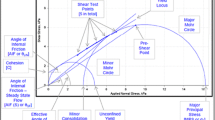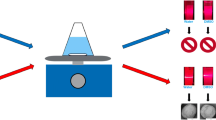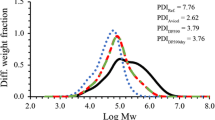Purpose
The aim of this study was to investigate the mechanism of the effect of wet granulation process on the compaction properties of microcrystalline cellulose (MCC).
Methods
MCC alone and with hydroxypropyl cellulose (HPC) as a binder were wet granulated by a high-shear process using different granulation parameters (over- and undergranulated). Overgranulated batches were also ball milled after drying and compared to the unmilled material. MCC starting material and granulation were characterized for particle size distribution, surface area, porosity, and isothermal moisture uptake. Compaction behavior of the MCC and granulations was also studied using a compaction simulator.
Results
In all cases, the wet granulation process decreased MCC primary particle porosity. Wet granulation also reduced compactibility of MCC to different degrees. Overgranulated batch with HPC showed the lowest compactibility and was less compactible than the batch without HPC granulated using the same parameters. Ball-milled material showed an increase in porosity and was significantly more compactible than the unmilled granulation from the same batch.
Conclusions
The decrease in MCC compactibility after granulation is associated with the decrease in MCC primary particle porosity and in some cases with the formation of large dense granules as well. Under certain conditions, milling seems to counteract the effect of wet granulation on MCC compactibility.








Similar content being viewed by others
References
J. N. Staniforth A. R. Baichwal J. P. Hart P. W. S. Heng (1988) ArticleTitleEffect of addition of water on the rheological and mechanical properties of microcrystalline cellulose Int. J. Pharm. 41 231–236 Occurrence Handle10.1016/0378-5173(88)90198-6 Occurrence Handle1:CAS:528:DyaL1cXhtVWht7k%3D
C. Gustafsson H. Lennholm T. Iversen C. Nystroem (2003) ArticleTitleEvaluation of surface and bulk characteristics of cellulose I powders in relation to compaction behavior and tablet properties Drug Dev. Ind. Pharm. 29 IssueID10 1095–1107 Occurrence Handle10.1081/DDC-120025867 Occurrence Handle1:CAS:528:DC%2BD3sXptVOru7g%3D Occurrence Handle14677770
G. Buckton E. Yonemochi W. L. Yoon A. C. Moffat (1999) ArticleTitleWater sorption and near IR spectroscopy to study the difference between microcrystalline cellulose before and after wet granulation Int. J. Pharm. 181 41–47 Occurrence Handle10.1016/S0378-5173(98)00413-X Occurrence Handle1:CAS:528:DyaK1MXjslGqur0%3D Occurrence Handle10370201
Y. Nakai S. Fukuoka S. Nakajima K. Yamamoto (1977) ArticleTitleCrystallinity and physical characteristics of microcrystalline cellulose. II. Fine structure of ground microcrystalline cellulose Chem. Pharm. Bull. 25 2490–2496 Occurrence Handle1:CAS:528:DyaE1cXhtFygsQ%3D%3D
R. Huttenrauch (1971) ArticleTitleIdentification of hydrogen bonds by means of deuterium exchange demonstration of binding forces in compressed cellulose forms Pharmazie 26 645–646
G. P. Millili R. J. Wigent J. B. Scwartz (1996) ArticleTitleDifferences in mechanical strength of microcrystalline cellulose pellets are not due to significant changes in degree of hydrogen bonding Pharm. Dev. Technol. 1 IssueID3 239–249 Occurrence Handle1:CAS:528:DyaK28Xms1aksbo%3D Occurrence Handle9552306
T. Suzuki H. Kikuchi S. Yamamura K. Terada K. Yamamoto (2001) ArticleTitleChange in characteristics of microcrystalline cellulose during wet granulation using a high shear mixer J. Pharm. Pharmacol. 53 609–616 Occurrence Handle1:CAS:528:DC%2BD3MXktVWltr8%3D Occurrence Handle11370700
P. Kleinebudde (1997) ArticleTitleThe crystallite gel model for microcrystalline in wet granulation, extrusion and spheronization Pharm. Res. 14 IssueID6 804–809 Occurrence Handle10.1023/A:1012166809583 Occurrence Handle1:CAS:528:DyaK2sXkt1yitLg%3D Occurrence Handle9210201
R. Ek J. M. Newton (1998) ArticleTitleMicrocrystalline cellulose as a sponge as an alternative concept to the crystallite gel model for extrusion and spheronization J. Pharm. Pharmacol. 15 509–510 Occurrence Handle1:CAS:528:DyaK1cXjt1Kltr4%3D
S. I. F. Badawy M. M. Menning M. A. Gorko D. L. Gilbert (2000) ArticleTitleEffect of process parameters on compressibility of granulation manufactured in a high shear mixer Int. J. Pharm. 198 51–56 Occurrence Handle10.1016/S0378-5173(99)00445-7 Occurrence Handle1:CAS:528:DC%2BD3cXhs1yqur4%3D Occurrence Handle10722950
M. Wikberg G. Alderborn (1991) ArticleTitleCompression characteristics of granulated materials. IV. The effect of granule porosity on the fragmentation propensity and compactibility of some granulations Int. J. Pharm. 69 239–253 Occurrence Handle10.1016/0378-5173(91)90366-V Occurrence Handle1:CAS:528:DyaK3MXitlCqur0%3D
B. Johansson M. Wickberg R. Ek G. Alderborn (1995) ArticleTitleCompression behavior and compactability of microcrystalline cellulose pellets in relation to their pore structure and mechanical properties Int. J. Pharm. 117 57–73 Occurrence Handle10.1016/0378-5173(94)00295-G Occurrence Handle1:CAS:528:DyaK2MXjs1Gis7Y%3D
S. Westermarck A. M. Juppo L. Kervinen J. Yliruusi (1999) ArticleTitleMicrocrystalline cellulose and its microstructure in pharmaceutical processing Eur. J. Pharm. Biopharm. 48 199–206 Occurrence Handle1:CAS:528:DC%2BD3cXhtl2isQ%3D%3D Occurrence Handle10612030
P. A. Webb and C. Orr. Analytical Methods in Fine Particle Technology. Micromeritics Instrument Corp., Norcross, GA, 1997, pp. 157, 80.
R. Ek G. Alderborn C. Nystrom (1994) ArticleTitleParticle analysis of microcrystalline cellulose: differentiation between individual particles and their agglomerates Int. J. Pharm. 111 43–50 Occurrence Handle10.1016/0378-5173(94)90400-6 Occurrence Handle1:CAS:528:DyaK2cXlvVKqu7g%3D
G. Zografi M. J. Kontny (1986) ArticleTitleThe interaction of water with cellulose- and starch-derived pharmaceutical excipients Pharm. Res. 3 187–194 Occurrence Handle10.1023/A:1016330528260
Author information
Authors and Affiliations
Corresponding author
Rights and permissions
About this article
Cite this article
Badawy, S.I.F., Gray, D.B. & Hussain, M.A. A Study on the Effect of Wet Granulation on Microcrystalline Cellulose Particle Structure and Performance. Pharm Res 23, 634–640 (2006). https://doi.org/10.1007/s11095-005-9555-z
Received:
Accepted:
Published:
Issue Date:
DOI: https://doi.org/10.1007/s11095-005-9555-z




